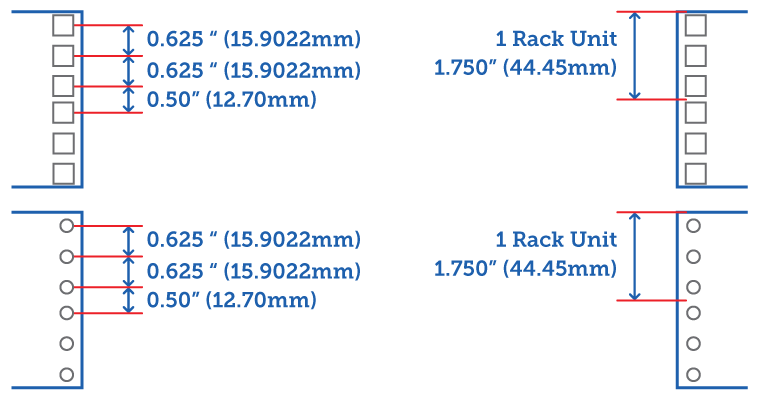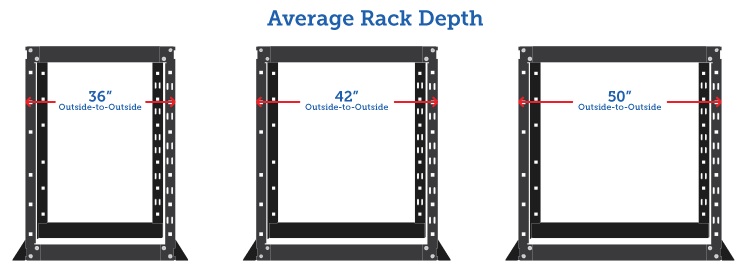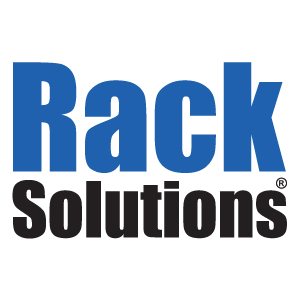12u Rack. Can I Install Different Accessories on Front and Back Rails
When building a server, deciding between a variety of mounting options can be intimidating. There are tons of server rack sizes to fit all of the different ways that people use servers. Unfortunately, it's not as simple as home, small business and data center sizing, in a small, medium and large format.
Understanding just a few variables will allow you to make an educated purchase in no time. As long as you know the depth, height and width that your server and accessories require, you can end up with a purchase that you won't need to return. Secondary factors like thermal requirements and security are good to think about in advanced, but can be manipulated more than the rack itself.

Server Rack Height

Server rack height is one of the more popular ways to classify a server. People often label their rack by its specific height, such as "42U server racks" or, much more informal, "7-foot racks."
the "U" in "42U" is stands for "rack units," or "U-spaces," which equal 1.75 inches. If you are investing in data center racks, the standard height is 48U ("7-foot rack") or, on some occasions, 42U. The reason this has become "standard" is because it is large enough to allow room for growth and small enough to access equipment easily. For rack enclosures, you might also encounter 22U and 27U racks. In the data center industry, you would consider this a standard "half-rack."
Plenty of people in the rack infrastructure business build non-standard sizes. This is especially true for open-frame racks. Because of their lighter weight and versatility, open-frame racks can reach heights of up to 70U. At the same time, they can be as small as 5U. Server rack cabinet enclosures, on the other hand, can be a non-standard 18U or 37U.
Server Rack Depth

Unlike height, server rack depth is commonly measured in inches and has is much less variation in sizes. Server racks can range from 0 to 50-inches in depth, but are commonly seen at 24 and 48-inch depths. A 24-inch rack would be perfect for housing network equipment, AV equipment, patch panels, etc.
A 29-inch depth, which is standard for open-frames, is compatible with many servers from Dell, HP, IBM, and Cisco. Any depth greater than that can either house larger equipment or provide extra space for cable management and other accessories. Even if you have a high depth rack, rails with adjustable mounting depths can help a shorter server fit perfectly.
Server Rack Width

The most common standard server rack width is 19 inches.Most rack-mounted equipment, especially servers, have a mounting width of 19 inches measured from one hole to another. Thus, the rack must be 19 inches across in order to fit this technology.
Many racks today come with a exterior width of 24 inches. A 24-inch exterior width works well sense in the data center industry because of the standard 48-inch floor panel. Data center floor panels are typically 24 in. x 24 in. Thus, a standard rack with a depth of 48 inches and a width of 24 inches makes it much easier to match up your racks with your available floor space. A rack with a 24-inch depth keeps things rather simple as well because it takes up exactly one panel.
There are plenty of racks that have a 19 inch mounting width and 24 exterior width. This allows for space on the edge to manage cables, mount PDUs or monitoring equipment while optimizing floor space.
2-post racks vs. 4-post racks
The final element to consider when looking at server rack sizes is the rack type. 2-post racks and 4-post racks have an inherent difference in depth.
A 2-post rack is constructed from two vertical upright support beams while a 4-post rack is constructed from four beams. A 2 post rack's mounting depth limitations depend on construction rather than another set of posts getting in the way. Still, most of the time, 2-post racks are best for lighter technology or accessories that require less depth. This includes switches, patch panels, routers, and telecommunication equipment.
4 Post Racks, on the other hand, can carry much more weight than 2 post racks because rails and shelves connect on all 4 posts. On one hand, this give you more mounting depth requirements than 2 post racks, but it is made up for in sturdiness.
Even though 2-post racks have stringent depth and weight restrictions, they can be as tall as a standard data center rack. 2-post "half-racks" are around 24U and full-sized racks are around 45U in height. Another reason they can be found a bit taller than expected is because some 2-post racks can be converted to a 4-post rack. With a caster kit, a 2-post can make the easy switch to a 4-post.
Which Server Rack Size is right for me?
Now that we have covered all the different elements that make up the size of your server rack, you must consider your overall set-up and your plans for installation.
If you are installing a rack for a home or office set-up with limited equipment, a half-rack or smaller might be the way to go. Unless you have very small equipment, you should use a 4 post rack because they are designed to be mounted from the front and back. Furthermore, mounting in a lockable, enclosed server rack will protect your equipment from being tampered with. This is recommended unless you keep the equipment in a locked room.
Perhaps you are preparing to install your rack in a server room or data center. It's best to overestimate how much space you need in case your business grows and needs change. For the time being, empty space can be filled with blanking panels to maintain proper airflow. Data centers have to place greater emphasis on floor space taken up. If you find server racks that match the specific dimensions of your floor panels, it makes the organization and installation process much simpler.
Regardless of what size rack you determine is right for you, always make sure to consider your layout and limits first.

Summary

Article Name
Server Rack Sizes: Understanding the Differences - RackSolutions
Description
When decidining between different server rack sizes, make sure that you know what depth, width and U space is needed for your setup
Author
Patrick Cleath
Publisher Name
RackSolutions
Publisher Logo

12u Rack. Can I Install Different Accessories on Front and Back Rails
Source: https://www.racksolutions.com/news/blog/server-rack-sizes/
0 Response to "12u Rack. Can I Install Different Accessories on Front and Back Rails"
Enregistrer un commentaire